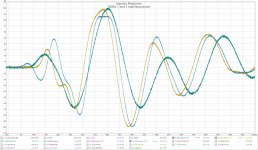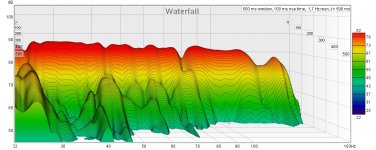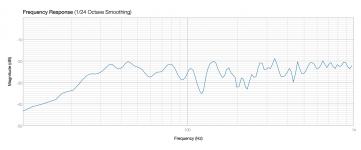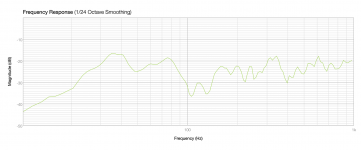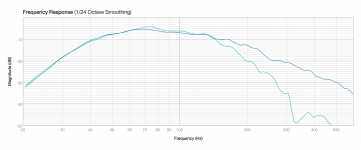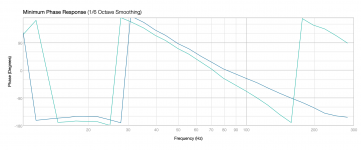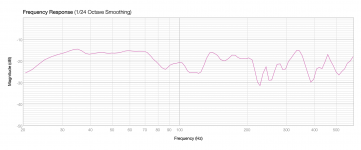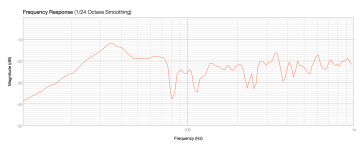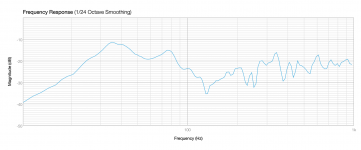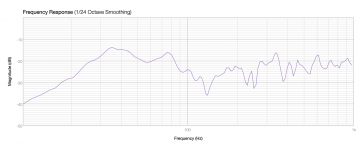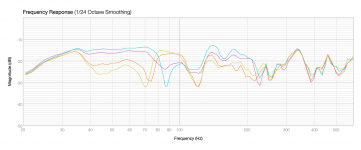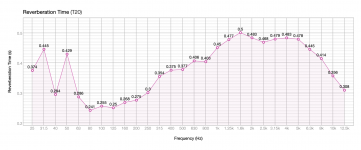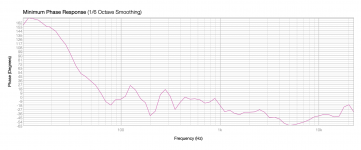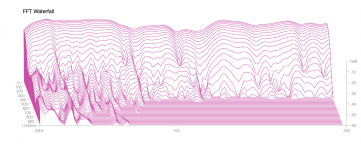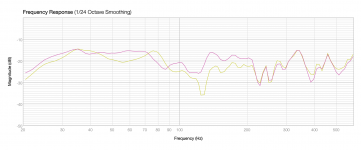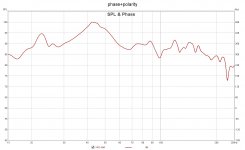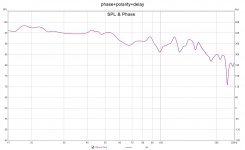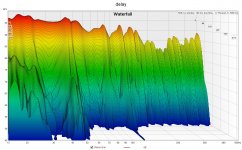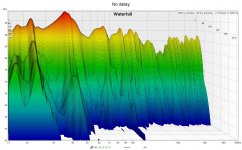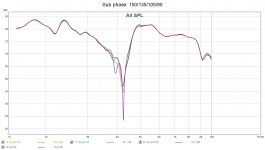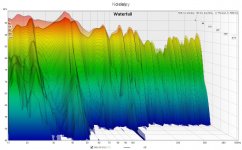At this moment I refuse to believe that.That the recording industry for ya!
I would agree that:"Listening on a low budget system masks everything so one can't hear so many details"
I'm still thinking something isn't right yet.
How do you check if subs are time aligned?
I'm afraid mine aren't so I have to check that out.
Since I have equidistant pairs I'm wondering if both pair should have same phase settings?
Last edited:
The age-old question of when is a design done! In engineering we usually have specs that have to be reached, but here we don;t really have that, so when you are done depends mostly on you. More time etc. will almost always improve things to a measurable degree, but not necessarily a perceptive one. The curve needs to be smooth and I prefere a subtle rise to the lowest freqs. How smooth, I jusy don;t think that there is a good answer to that.Quick question; what does it take for you to consider the bass issue a solved problem in a room? Aka the point where you feel there's nothing to gain by going further?
If I may dig deeper into the ringing thingIs it correct that exessive EQ might cause ringing, in the same manner, as it could remove/lower it? Or would it be less audible at low frequencies, compared to higher ones - at let's say 500 or 3khz?
LF EQ should not ring because one should not be using very high Q filters such that they would ring. This is another reason that LF damping and multiple subs helps. It smoothes things requiring far lower Q electrical filters and hence no ringing. The bottom line here is that ringing and smoothness go hand-in-hand. If the curves is very smooth then it cannot be ringing to a large extent. This is why waterfalls are somewhat misleading in that they don't show you anything that the FR doesn't. You should never find a situation where you have a smooth LF curve and yet have significant ringing.
A room cannot really ring at above modal frequencies because at any frequency there are hundreds of modes being excited and only the average of this will show on a waterfall. This average will not ring (unless the source rings) because the average of the modes will mask the ringing of any individual mode. Rooms act very differently above and below the modal transition.
At this moment I refuse to believe that.
I'm still thinking something isn't right yet.
How do you check if subs are time aligned?
I'm afraid mine aren't so I have to check that out.
Since I have equidistant pairs I'm wondering if both pair should have same phase settings?
Believe what you want, but time alignment at LFs with multiple subs is a waste of time. The timing difference at LFs will be only a fraction of the period so in essence only a small phase change will result. This will be audible only to the extent that it changes the frequency response. But if the FR is set with and without the delay then the end result will be the same either way. The ear does cannot resolve time differences at the low frequencies.
Now if you have a single sub and a crossover, which I think is a very bad idea, then the delay will change the phase at the crossover and this will have an audible effect. So don't do that! With multiple subs and no crossover such an effect will not occur.
But changing phase is time alignment, no?Believe what you want, but time alignment at LFs with multiple subs is a waste of time. The timing difference at LFs will be only a fraction of the period so in essence only a small phase change will result. This will be audible only to the extent that it changes the frequency response. But if the FR is set with and without the delay then the end result will be the same either way. The ear does cannot resolve time differences at the low frequencies.
When I change phase and check impulse response plot the front two subs are better matched. See the attachment. SPL has also improved.
My understading is they are better time-aligned as phase is an aproximation of delay.
Attachments
Thank you for responding. I guess it's impossible to know, it's probably 100% dependant on source material anyways. Well, if it's good enough, it's good enough!The age-old question of when is a design done! In engineering we usually have specs that have to be reached, but here we don;t really have that, so when you are done depends mostly on you. More time etc. will almost always improve things to a measurable degree, but not necessarily a perceptive one. The curve needs to be smooth and I prefere a subtle rise to the lowest freqs. How smooth, I jusy don;t think that there is a good answer to that.
Phase and time are two different things. You can have phase alignment and still be a cycle off.But changing phase is time alignment, no?
When I change phase and check impulse response plot the front two subs are better matched. See the attachment. SPL has also improved.
My understading is they are better time-aligned as phase is an aproximation of delay.
If I'm not mistaken, phase is where the driver starts its motion through the cycle, time is when.
Attachments
Call me lazy if you will, but I have not gone through all 277 pages of this thread to see if what I'm looking for has already been posted.
Swarm in concept (4-subs for music), I'm looking for a discreet looking approach for a small room 7'H x 11'W x 15' L.
What I have in mind in maybe an enclosure 3-1/2"H x 15"W x 20"L and maybe 6" woofers or less.
The idea is to make shallow subs that are placed at floor, ceiling and mid-height wall to find the right spots, and then later perhaps bury them in the wall.
All I see is vented designs on Parts-Exp, I would have rather have sealed and or opposing driver configurations rather than ported.
I did not see anything affordable on the market so I'm assuming I'd have to build something.
30 years ago I had some Cambridge Soundworks sealed subwoofers for a while, but think I can do better just winging it.
Cambridge Soundworks PSW1 master AND slave subwoofer SET
Cambridge Soundworks PSW1 master AND slave subwoofer SET | | Reverb
Have you gentlemen seen anything like this lately?
I have one large subwoofer now, but reserve that for Home Theater duty.
The 4-sub system will be for 2-channel music only.
EDIT:
I wonder if K&K (Miller & Kreisel) made any smaller than the K9.
Swarm in concept (4-subs for music), I'm looking for a discreet looking approach for a small room 7'H x 11'W x 15' L.
What I have in mind in maybe an enclosure 3-1/2"H x 15"W x 20"L and maybe 6" woofers or less.
The idea is to make shallow subs that are placed at floor, ceiling and mid-height wall to find the right spots, and then later perhaps bury them in the wall.
All I see is vented designs on Parts-Exp, I would have rather have sealed and or opposing driver configurations rather than ported.
I did not see anything affordable on the market so I'm assuming I'd have to build something.
30 years ago I had some Cambridge Soundworks sealed subwoofers for a while, but think I can do better just winging it.
Cambridge Soundworks PSW1 master AND slave subwoofer SET
Cambridge Soundworks PSW1 master AND slave subwoofer SET | | Reverb
Some say the Cambridge Soundworks' (CSW) SW1 Sub and Slave were the only good products the company ever made.............
Have you gentlemen seen anything like this lately?
I have one large subwoofer now, but reserve that for Home Theater duty.
The 4-sub system will be for 2-channel music only.
EDIT:
I wonder if K&K (Miller & Kreisel) made any smaller than the K9.
Last edited:
6" woofers sound pretty small to me (even four of them,) but might work at lower levels. They will "clip" very easily with EQ at LFs.
I have about four or five 15" drivers to cover the LF range. They don't "clip".
I'm thinking these are low output to smooth out room modes/nodes. Not looking to shake the house down.
Sticking out from the wall 3-1/2" is very different than 6" found with many so-called slim designs.
I may still have my 4" woofers that I bought from Radio Shack 35 years ago in a box. In the back of my head I still want to use them, but they only take a few watts as they are car speakers I think. They have been part of many experimental speakers over the years.
EDIT:
I could do some tubes on the wall in various orientations, that would break things up.
Sound-O-Light Speakers
Surprisingly simple PVC pipe speakers are clear shining performers.
Sound-O-Light Speakers | Make:
Last edited:
I have followed the literature on the multi-sub approach. Recently there was a great sale on my subs so I was able to get two more for a total of 4.
Mains are JBL LSR 6332 (ported 12" W):
https://www.jbl.com/on/demandware.s...ult/dw2e824d49/pdfs/JBL_LSR6332_SpecSheet.pdf
Subs are JBL 550P, 10", sealed:
https://www.jbl.com/on/demandware.s...ecification Sheet - SUB 550P (English EU).pdf
The subs have a line input with variable XO, 50-150Hz and a LFE input. Phase switch between 0, 180 degrees.
All graphs shown are with subs out of phase (180). Low frequency extension was compromised with any 0 phase settings (? from the phase of the port roll-off of the mains).
One sub is under each main. The back corners have 1 each.
The room is 14x15x8. Beside the left speaker there is a large opening into the hall/rest of the upstairs (pretty clear based on the measurements).
I have Fuzzmeasure on my Mac so used it for measurements. Happy to clarify anything about them.
Running into the LFE inputs didn't seem to do as well. I tried all 4, fronts only, rear only.
What do you think?
Bill
1- L main average
2- R main average
3- Sub FR XO and LFE
4- Sub phase with XO and LFE
Mains are JBL LSR 6332 (ported 12" W):
https://www.jbl.com/on/demandware.s...ult/dw2e824d49/pdfs/JBL_LSR6332_SpecSheet.pdf
Subs are JBL 550P, 10", sealed:
https://www.jbl.com/on/demandware.s...ecification Sheet - SUB 550P (English EU).pdf
The subs have a line input with variable XO, 50-150Hz and a LFE input. Phase switch between 0, 180 degrees.
All graphs shown are with subs out of phase (180). Low frequency extension was compromised with any 0 phase settings (? from the phase of the port roll-off of the mains).
One sub is under each main. The back corners have 1 each.
The room is 14x15x8. Beside the left speaker there is a large opening into the hall/rest of the upstairs (pretty clear based on the measurements).
I have Fuzzmeasure on my Mac so used it for measurements. Happy to clarify anything about them.
Running into the LFE inputs didn't seem to do as well. I tried all 4, fronts only, rear only.
What do you think?
Bill
1- L main average
2- R main average
3- Sub FR XO and LFE
4- Sub phase with XO and LFE
Attachments
Last edited:
continued
1- mains+L sub XO 150
2- mains+ L/R sub with XO
3- mains with 3 subs
4- mains with 4 subs
1- mains+L sub XO 150
2- mains+ L/R sub with XO
3- mains with 3 subs
4- mains with 4 subs
Attachments
last ones
1- Mains only in green, 4 subs in pink
2- Mains and 4 subs CSD
3- Mains and 4 subs phase
4- Mains and 4 subs RT60
5- Mains with subs all XO (pink), all LFE (orange), LFE front subs only (blue), LFE rear subs only (green)
1- Mains only in green, 4 subs in pink
2- Mains and 4 subs CSD
3- Mains and 4 subs phase
4- Mains and 4 subs RT60
5- Mains with subs all XO (pink), all LFE (orange), LFE front subs only (blue), LFE rear subs only (green)
Attachments
OK, I made a progress. I believe I'm done, the sound is great, FR looks good too.Believe what you want, but time alignment at LFs with multiple subs is a waste of time. The timing difference at LFs will be only a fraction of the period so in essence only a small phase change will result. This will be audible only to the extent that it changes the frequency response. But if the FR is set with and without the delay then the end result will be the same either way. The ear does cannot resolve time differences at the low frequencies.
I'm not a native speaker so it's possible to I'm not understanding you well enough.
Changing phase and polarity is time alignment, right?
We can also ignore phase/polarity settings and align our subs with delay.
In my case, I got this result with phase/polarity settings (picture 1).
Then I delayed rear pair and got this (picture 2).
Seems to me time alignment is crucial for optimal results. I'm not sure if I could get the same result without delay but I'm pretty positive I could get it using only delay.
Attachments
Last edited:
Polarity and phase are not the same thing as delay. With delay the phase changes with frequency and with the other two it does not.
But delay in the subs would be a decent idea, just don't base it on anything like distance. I would think that , maybe, a 1ms delay in one a 2 ms delay in the next and so on. That might work well. DElay has a real "mixing" effect on the modes.
But delay in the subs would be a decent idea, just don't base it on anything like distance. I would think that , maybe, a 1ms delay in one a 2 ms delay in the next and so on. That might work well. DElay has a real "mixing" effect on the modes.
Can't say I agree with that. I suspect you may have mistyped the explanation.
Polarity and delay are not frequency dependant while phase is. So frequency changes with the phase.
If delay would mess with modes then this would show on a waterfall, no?
In my case it didn't. Delay was set to 11 ms.
Polarity and delay are not frequency dependant while phase is. So frequency changes with the phase.
If delay would mess with modes then this would show on a waterfall, no?
In my case it didn't. Delay was set to 11 ms.
Attachments
Last edited:
I suspect you may have mistyped the explanation.
There was no typo.
Polarity and phase are not the same thing as delay. With delay the phase changes with frequency and with the other two it does not.
Clearly, altering polarity introduces a 180 deg phase shift that's independent of frequency. Also, introducing a delay introduces a phase shift in radians that's directly proportional to frequency according to:
phase(rad) = -2 * pi * f(Hz) * T(sec)
But you've said "With delay the phase changes with frequency and with the other two it does not."
One of the "other two" is polarity, and indeed the phase of a polarity change is not a function of frequency. But you seem to be claiming the other quantity, namely "phase" can be independent of frequency (because it's part of the "other two"). So, are you of the view that the phase control of commercial subs introduces a phase shift that's independent of frequency, even though that phase shift is neither 0 nor 180 degrees, but is rather somewhere in between?
Last edited:
If delay would mess with modes then this would show on a waterfall, no?
In my case it didn't. Delay was set to 11 ms.
Sure looks to me like substantial differences from about 24 to 60 Hz
(sorry, gave up trying to suck the 2 waterfalls on your #2273 down to here without going through my box and back; then the temptation to mark them up would've been too great ..)
Last edited:
Care to explain?There was no typo.
Because this doesn't make sense. But than again, my understanding is pretty basic so I'm relying on my case and on the graphs I see.
I posted a graph where one can easily see that with changing the phase the FR changes as well... Not much but it certainly does.
If we measure a single sub with and without delay the FR would look exactly the same. The difference would only be noticed on impulse plot (impulse would still be the same but it would shift to the right on the x-axis. So how can delay make phase change with frequency?
If you have only one frequency, let's say 100 Hz, then phase can be equal to delay.
Last edited:
You mean like that?Sure looks to me like substantial differences from about 24 to 60 Hzabout where experience would predict ..
(sorry, gave up trying to suck the 2 waterfalls on your #2273 down to here without going through my box and back; then the temptation to mark them up would've been too great ..)
Yes, it's a nice change. I thought I would be able to sum all the subs up by using just gain/phase/polarity but obviously delaying the rear pair was necessary for a better result.
Attachments
6" woofers sound pretty small to me (even four of them,) but might work at lower levels. They will "clip" very easily with EQ at LFs.
I have about four or five 15" drivers to cover the LF range. They don't "clip".
Reed Exodus Anarchy 25hz Tapped Horn - Page 2 - AVS Forum | Home Theater Discussions And Reviews
Attachments
Hi Earl,
You have said that bass in a small room can be improved with reverberation (to emulate a larger room).
Your concept could be implemented with a PT2399 echo/reverb board.
a) What should be the delay between the reverb (echoes) and how much should the level be down from the previous reverb/echo sample? Do note there is a minimum delay of 30ms for PT2399.
b) In case of multi sub, I believe the reverb logic should be common to all the subs, right?
Have a nice day.
WA
You have said that bass in a small room can be improved with reverberation (to emulate a larger room).
Your concept could be implemented with a PT2399 echo/reverb board.
a) What should be the delay between the reverb (echoes) and how much should the level be down from the previous reverb/echo sample? Do note there is a minimum delay of 30ms for PT2399.
b) In case of multi sub, I believe the reverb logic should be common to all the subs, right?
Have a nice day.
WA
- Home
- Loudspeakers
- Subwoofers
- Multiple Small Subs - Geddes Approach
